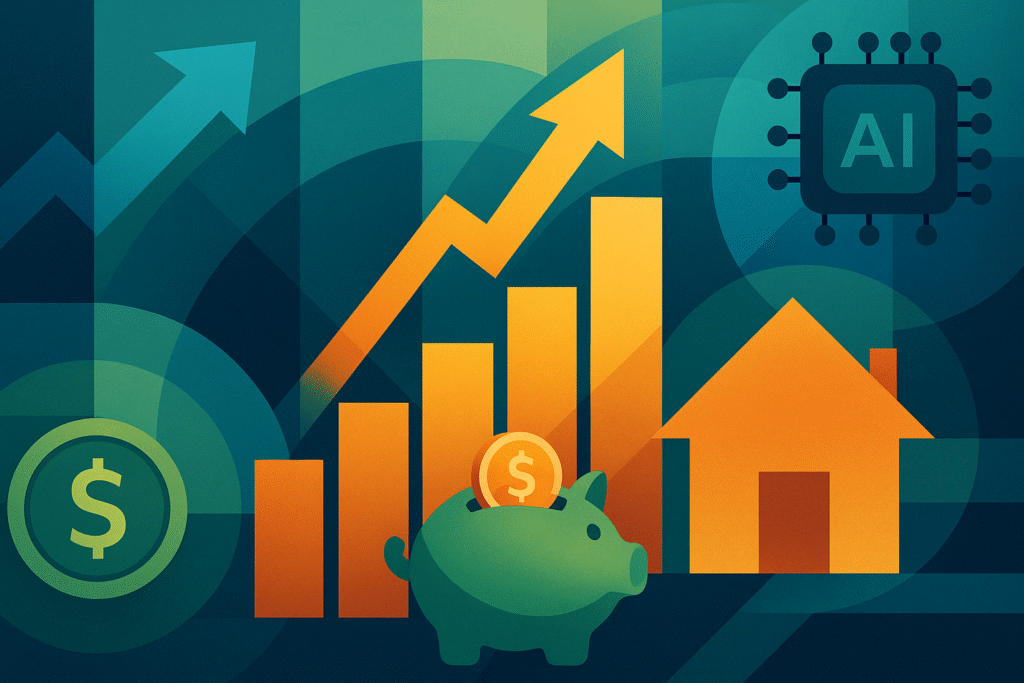Personal finance in 2025: what were the main trends that stood out?
Discover the key personal finance trends that shaped the U.S. in 2025, from AI-driven money management to new consumer behaviors.
What are the main trends in personal finance in 2025?

Personal finance in 2025 didn’t just evolve, it shifted in ways that permanently changed how Americans earn, spend, borrow, and build wealth.
Between persistent inflation pressures, rapid advances in AI-driven money management, and a new wave of consumer protection rules, the year became a turning point for households trying to regain financial stability and long-term security.
Below, we break down the key trends that defined personal finance in the U.S. throughout 2025, what fueled each shift, and what they mean for the future of money.
1. Americans Prioritized Financial Stability Over Growth
After several years of economic uncertainty, from inflation surges to fluctuating interest rates, U.S. consumers in 2025 embraced a more conservative financial mindset. A clear pattern emerged:
- Emergency savings became a top priority;
- Discretionary spending slowed, especially in travel, dining, and luxury goods;
- Budgeting apps saw a 30–40% increase in adoption compared to pre-2023 levels.
A Federal Reserve survey early in the year revealed that more than 60% of households felt unprepared for unexpected expenses, pushing people to rebuild cash buffers and reduce reliance on high-interest credit.
2. AI Took Over Daily Money Management
Artificial intelligence played a starring role in personal finance throughout 2025. What began as simple budgeting tools evolved into automated financial assistants capable of analyzing spending, projecting cash flow, identifying unnecessary fees, and even recommending investment adjustments.
AI became integrated into everyday banking apps, transforming how users interacted with their money. Younger adults especially embraced this trend, preferring automated guidance over manual tracking.
For many households, these tools became the primary support system for building financial discipline and long-term planning.
3. Multiple Income Streams Became the New Normal
Relying on a single source of income felt increasingly risky, and 2025 solidified the rise of multi-income living.
Americans explored new ways to supplement earnings, whether through freelancing, digital products, gig work, or small-scale entrepreneurship.
Economic pressures pushed many to diversify their income as a strategy for debt reduction, savings growth, and greater financial independence.
Gen Z led the movement, treating alternative income as a standard component of their economic life rather than a temporary solution or side project.
4. High-Interest Debt Remained a Pressure Point
Despite better financial planning, credit card debt hit record levels early in 2025. High interest rates, some surpassing 25% APR, pushed consumers to look for alternatives:
- Balance transfer cards with extended 0% APR periods;
- Personal loans for debt consolidation;
- Credit builder products for those with thin or damaged credit files;
- AI-driven debt payoff planners.
At the same time, Americans became more sensitive to financial literacy content, seeking educational blogs, YouTube channels, and TikTok explainers to understand how to navigate persistent debt.
5. Stronger Consumer Protections Reshaped Decision-Making
New consumer protection rules introduced throughout the year had a significant impact on how Americans evaluated financial products.
Transparency became a major theme, especially in credit card terms, Buy Now, Pay Later services, and personal loan offerings.
Financial apps faced stricter privacy regulations, making users more attentive to how their data was being used.
As a result, consumers became more skeptical and more deliberate, spending extra time reviewing terms, researching lenders, and comparing digital financial tools before committing.
6. Investments Tilted Toward Long-Term Security
Investors in 2025 adopted a more grounded and cautious approach. Instead of chasing high risk and fast returns, Americans favored diversified and stable strategies.
Index funds, ETFs, and treasury-backed products regained popularity as individuals sought predictability amid market fluctuations.
While crypto remained part of many portfolios, the focus shifted toward regulated assets with stronger fundamentals.
At the same time, companies connected to AI and long-term sustainability continued to draw steady attention from investors looking for reliable, future-oriented opportunities.
A Year That Redefined Money Habits
Looking back, 2025 was a year where practicality, digital innovation, and financial resilience shaped everyday life.
Americans sought stability in their budgets, diversification in their income, and more reliable tools to support their financial decisions.
The trends that stood out, from advanced AI tools to new housing solutions, suggest a lasting shift toward financial adaptability and smarter, more intentional money management.





